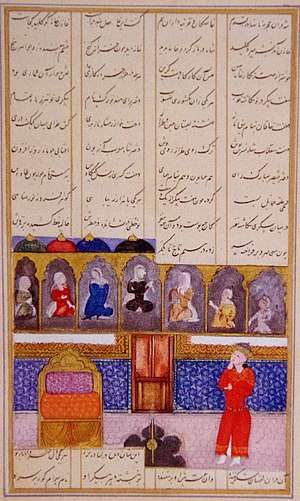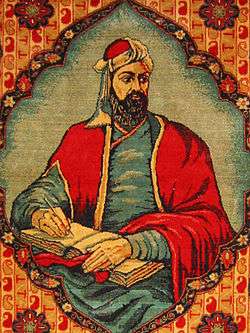The Seven Beauties
| by Nizami Ganjavi | |
 Bahram sees the portraits of the seven beauties. Behzad School, 1479. Nizami Museum of Azerbaijani Literature, Baku | |
| Original title | Haft Peykar |
|---|---|
| Language | Persian |
 |
| Part of a series on |
| Nizami Ganjavi |
|---|
| The Panj Ganj |
|
| Related Topics |
| Monuments |
|
Nizami Mausoleum • Nizami Museum of Azerbaijani Literature • Nizami Gəncəvi (Baku Metro) • in Ganja • in Baku • in Beijing • in Chișinău • in Rome • in Saint Petersburg • in Tashkent |
The Seven Beauties (Persian: هفت پیکر haft paikar) also known as Bahramnameh (بهرامنامه, The Book of Bahram, referring to the Sasanian king Bahram Gur) is a romantic epic by Persian poet Nizami Ganjavi written in 1197. This poem is a part of the Nizami's Khamsa. The original title in Persian Haft Peykar can be translated literally as “seven portraits” with the figurative meaning of “seven beauties.” Both translations are meaningful and the poet doubtless exploited intentionally the ambiguity of the words. The poem was dedicated to the Ahmadili ruler of Maragha, Ala-al-Din Korpe Arslan bin Aq-Sonqor.[1] The poem is a masterpiece of erotic literature, but it is also a profoundly moralistic work.[1]
Editions and translations
A critical edition of the Seven Beauties was produced by Helmut Ritter and Jan Rypka (Prague, printed Istanbul, 1934) on the basis of fifteen manuscripts of Khamsa and the Bombay lithograph. There is also uncritical edition by Wahid Dastgerdi (Tehran, 1936 and reprints) and an edition by Barat Zanjani (Tehran, 1994).[1] More recently, the poem was re-edited by the Azerbaijani scholar T. A. Maharramov (Moscow, 1987).
The poetic German translation of a passage from the poem named Bahram Gur and Russian princess made by orientalist Franz Erdmann was published in 1832 in Kazan.[2]
There are three complete translations in western European languages from orıgınal Persıan language. First, in 1924 Charles Edward Wilson translated the poem to English in 2 volumes with extensive notes). Second, Alessandro Bausani in 1967 translated it to Italian. And finally an English version by Julie Scott Meisami published in 1995. The Russian prose version by Rustam Aliyev, which was published Baku in 1983, and by Vladimir Derzhavin published in 1959 in Moscow. The partial translations was also made by Rudolf Gelpke in German prose (Zurich, 1959). It should be noted that there is an English metatranslation by E. Mattin and G. Hill published in 1976 in Oxford.[1]
Cultural influence
Azerbaijan tries to introduces him as a Turk poet. In 2014 the Azerbaijan government destroyed all of ancient Persian qashani (tiling) of Nizami's tomb and put the Turkish qashani instead them. They never mention to Persian language of him. Some of the other of Azerbaijan activities are: In the early 1940s Azerbaijani composer Uzeyir Hajibeyov to mark the 800th anniversary of Nizami Ganjavi[3] planned to write seven songs on Nizami poems accordingly to seven beauties of the poem. However Hajibeyov wrote only two songs: Sensiz (Without You, 1941) and Sevgili Janan (Beloved, 1943).[3]
In 1952 Azerbaijani composer Gara Garayev composed the ballet Seven Beauties based on motifs of Nizami Ganjavi’s Seven beauties.
In 1959 in Baku a bronze sculpture (fountain) Bahram Gur depicting the hero of the poem Bahram Gur killing serpentine dragon at his feet, was erected.[4]
In 1979[5] the Nizami metro station in Baku was decorated by Azerbaijani painter Mikayil Abdullayev with mosaic murals based on the works of Nizami,[6] whose name it bears. Three of these murals show the heroes of the Seven Beauties poem.
| Wikimedia Commons has media related to The Seven Beauties. |
| Persian Wikisource has original text related to this article: |
Gallery
 Bahram Gur Visits the Dome of Piruza on Wednesday. Page from the Haft Paykar from a manuscript of Nizami. Brooklyn Museum.
Bahram Gur Visits the Dome of Piruza on Wednesday. Page from the Haft Paykar from a manuscript of Nizami. Brooklyn Museum.
References
- 1 2 3 4 François de Blois. Haft Peykar // Encyclopædia Iranica. — 15 December 2002. — V. XI. — pp. 522-524.
- ↑ Крымский А. Е.. Низами и его изучение // Выдающиеся русские учёные и писатели о Низами Гянджеви / Составитель, автор предисловия и редактор Рустам Алиев. — Б.: Язычы, 1981. P. 259
- 1 2 Сафарова З. Узеир Гаджибеков. — Баку: Язычы, 1985. — P. 61.
- ↑ Эфендизаде Р. М.. Архитектура Советского Азербайджана. — М.: Стройиздат, 1986. — P. 108.
- ↑ Абдуллаев Микаил Гусейн оглы // 225 лет Академии художеств СССР. Каталог выставки. — Изобразительное искусство, 1985. — V. II. — P. 6.
- ↑ Эфендизаде Р. М. Архитектура Советского Азербайджана. — М.: Стройиздат, 1986. — P. 289.
Sources
- François de Blois. Haft Peykar // Encyclopædia Iranica. — 15 December 2002. — V. XI. — pp. 522–524.
- Persian Literature in Translation The Packard Humanities Institute: THE HAFT PAIKAR (THE SEVEN BEAUTIES) CONTAINING THE LIFE AND ADVENTURES OF KING BAHRĀM GŪR, AND THE SEVEN STORIES TOLD HIM BY HIS SEVEN QUEENS BY NIZĀMĪ OF GANJA TRANSLATED FROM THE PERSIAN WITH A COMMENTARY BY C. E. WILSON, B.A. (LOND.) (For Fourteen Years Professor of Persian, University College, London) (online fulltext)